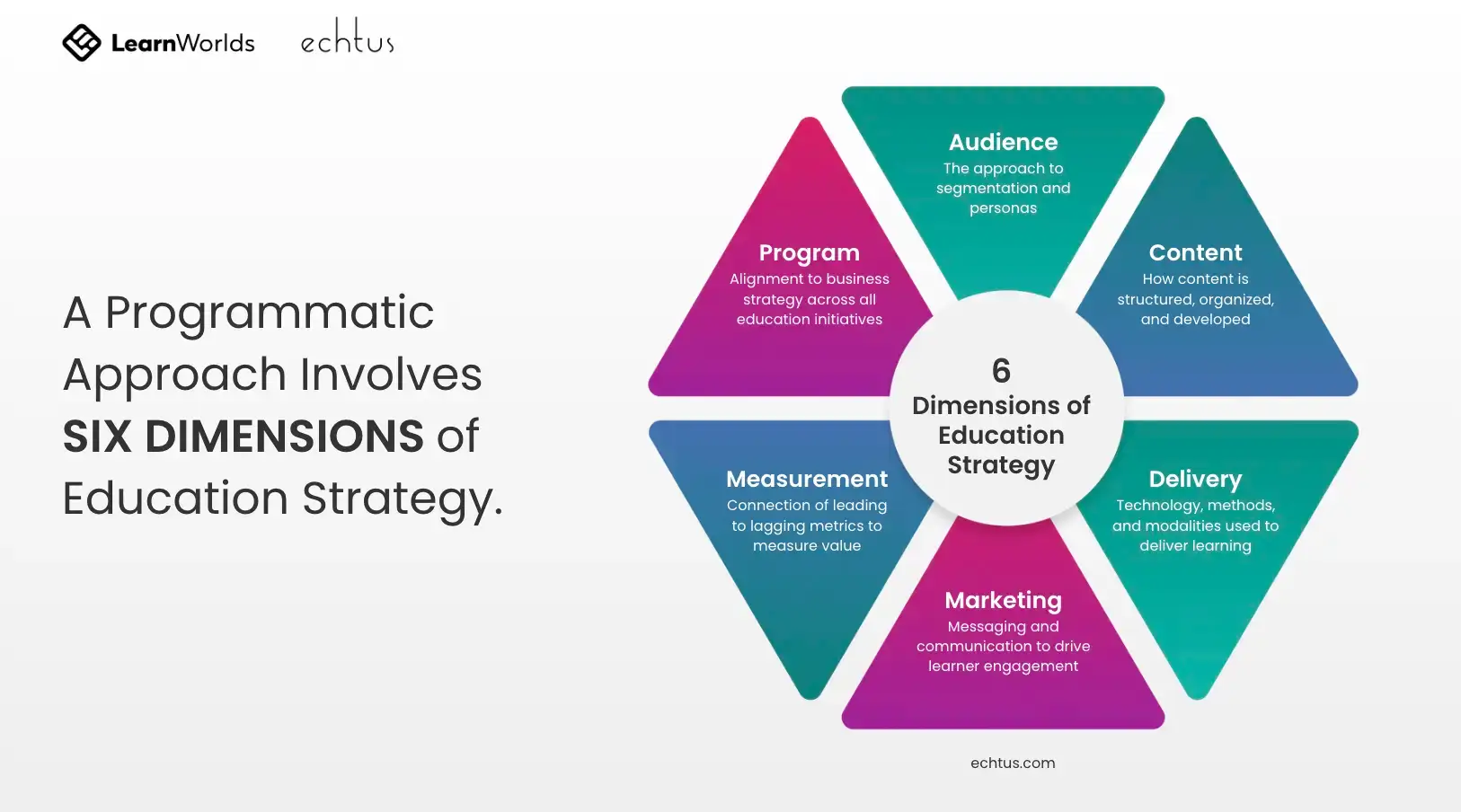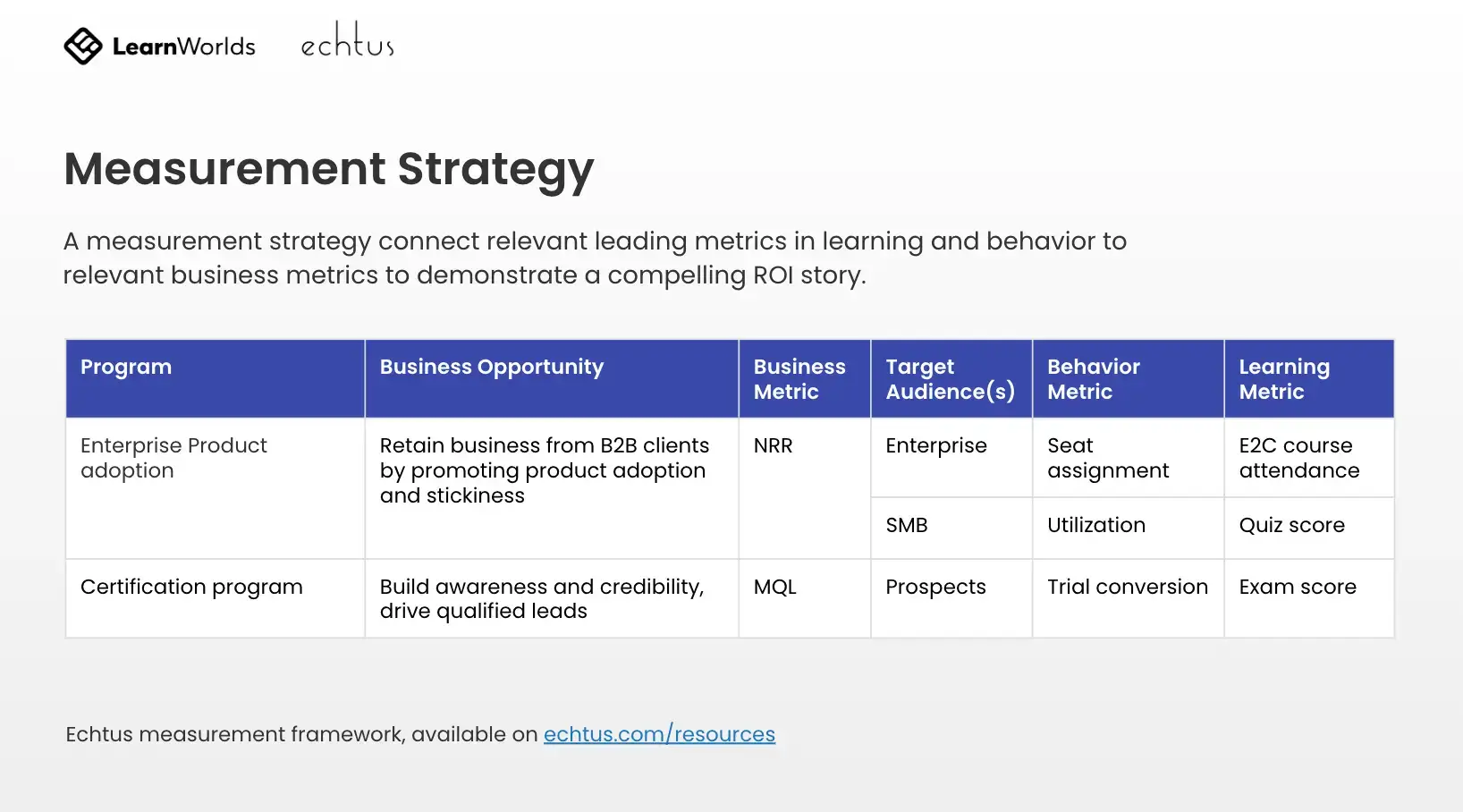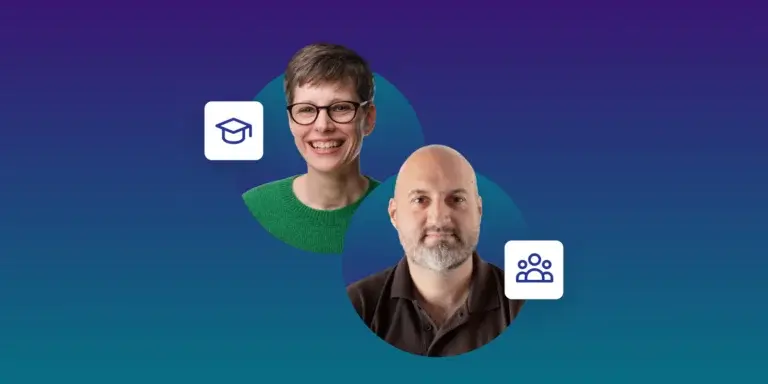Table of Contents
In a recent webinar, we had the pleasure of hosting Vicky Kennedy, CEO of Echtus and an expert in customer education, alongside Panos Siozos, CEO of LearnWorlds. They shared proven strategies for successfully implementing a customer education program. Vicky also introduced her measurement framework, designed to demonstrate the tangible impact of such programs.
The webinar was a big success, and we’re glad we were able to answer so many of your questions and help you dive a bit deeper into the topic.
Don’t miss out on the opportunity to transform your customer education efforts. Watch the webinar on demand and gain insights that will help you drive real results!
In the meantime, here’s a quick recap of what we covered:
You may have heard it as customer enablement, customer training, product education, or product training – they all refer to the same thing. Customer education was born a couple of decades ago and grew from the concept of training your customers on how to use your tools to what it is today.
The term “customer education” has two meanings:
Whatever the case, customer education has multiple benefits and can drive a wide range of results that elevate a business.
Product-Centric Education vs. Other Learning Initiatives
Naturally, customer education is not the only type of education a business offers. Education in a business can show up in different forms:
✅For compliance: linked to auditing and legal training and involves departments like IT and HR.
💡As a service: product training that is sold to the customer, aka revenue generating, like a paid webinar.
🎯As a strategy: when you’re using education and its outcomes to achieve other goals in your company, like increasing customer retention/performance or reducing cost.
When using education as a strategy, you expect an ROI from these outcomes. It’s a more nuanced initiative and it’s complicated to measure the results.
Misalignment between business strategy and customer education is one of the most common mistakes.
When using customer education as a business strategy, you need to be aware of and understand the current strategies across your company. That is why it’s important for people leading customer education initiatives to be embedded with department heads across the organization.
For example, your business is looking to expand into a new market – how can education drive that? Understanding the business goals and the strategy behind those goals is key and mandatory to maximize the business impact of customer education.
👉Very often, we see companies focusing on content creation and creating multiple courses to cover every possible topic and feature. While there’s nothing wrong with creating content, content alone will not drive the desired business results.
It’s important to have a customer education program to make sure the right people will get educated about the right things for the right reasons; it’s also key to measuring success.
Education program examples:
The Six Dimensions of a Customer Education Strategy
According to Vicky, a well-orchestrated customer education strategy has the following six dimensions:

Program
All education initiatives must be aligned with your business strategy. Take inventory of all the opportunities or problems that you need to solve at your organization (eg. early customer churn); if you want to measure the business impact you have to know what you want to impact!
Prioritize the most impactful initiatives, and take stock of what content you already have.
Audience
Even within your customers, you’ll have different audiences/segments. Ensure you understand their motivations, prior knowledge, challenges, and why they would want to learn from you for a more targeted and effective program.
Content
Having understood the two first dimensions of your strategy, you can move on to content creation. Although you can use content you already have, your content strategy should be developed with your business strategy and audience in mind.
Delivery
Program delivery is not only about the tech tools, like customer training software you’ll use to deliver your program but also the modality, e.g., ILT (instructor-led) or self-paced.
A common mistake for many organizations is to skip the first steps and pick the tech tools without having a foundation of what exactly they want to do.
Marketing
You need to focus on education marketing and connect the learner audience to the learning using their goals and motivations. The goal of marketing is to drive engagement and traffic to your learning program. Without marketing, you won’t get the results that you’re expecting.
Measurement
Measuring the business impact of customer education is absolutely necessary. It helps to have a proactive approach to measuring business impact, for example by using a measurement framework like the one Vicky has built.
A measurement strategy connects leading metrics (learning and behavior) to relevant business metrics (lagging metrics, like NRR) to demonstrate a compelling ROI story.
Leading metrics demostrate engagement with learning. When measuring learning, organization will often lean on these easier-to-get and understand metrics around engagement, like completion rates, attendance.
👉But if you only measure engagement metrics, although they’re extremely important, it’s hard to demonstrate business impact.
The following framework takes a programmatic approach and consists of both leading and lagging metrics:

So, based on the framework above, let’s say you have an “Enterprise Product adoption” program. The program is linked to a business opportunity to retain business from B2B customers by promoting product adoption and stickiness.
How will you measure the success of the education program at a business level?
In this case, your high-level business metric is NRR (Net Revenue Retention) – this is what you’re going to showcase to management to prove the value of your program.
You also need to break down your target audience, B2B, to specific segments – in this case, Enterprise and SMBs.
And how will you know that learning is actually happening?
You can measure learning using engagement metrics, like attendance rates or quiz scores, or even gamification. You can then connect these to the behavior metric (because ultimately learning is about changing behavior!).
In this case, if you’re trying to drive utilization (=product adoption and stickiness), you can link the quiz scores to utilization. And utilization, in turn, impacts your NRR.
Metrics that can translate into revenue are easier for executive leadership to understand. It will also be easier for you to showcase the impact of your program and even ask for more resources.
Even if you are sitting earlier in the funnel, you still need to measure something to demonstrate the impact of your program, eg., feature usage.
Closing our webinar, we mentioned the most important pillars you need to focus on when building your program. With these pillars in mind, you can also select a suitable customer education platform:
👥Engagement and community to facilitate interaction collaboration, and peer learning
🤖AI assistance for a more efficient experience
🎯User management for segmenting learners and providing a more personalized learning experience
🎨Branding and customization to bring forward your brand identity and offer a consistent user experience
📱Mobile app to improve accessibility on the go to boost engagement and participation
💰Monetization options as, at some point, you might want to generate revenue from your customer education or sell certification programs.
LearnWorlds is a top choice for customer education, offering features like advanced AI assistant, and built-in content authoring tools for fast course creation (including assessment and certificate builders), white-label website builder and mobile apps, interactive learning activities & built-in community.
Our platform also makes user management easy with access controls, user groups, tagging, bulk and automated actions, and more options. As for monetization, you will find every tool you need to promote and sell your program, either built-in or as an integration.
Moving Forward
Customer education is a powerful tool that can transform your business. It goes beyond simply providing content; it strategically aligns with your business goals to drive measurable outcomes such as increased retention, enhanced product adoption, and higher customer satisfaction.
By leveraging a well-crafted education program and implementing a strong measurement framework, like the one shared by Vicky Kennedy, you can prove the tangible impact of your efforts. Start building or refining your customer education strategy today, and unlock its full potential!
Further reading you might find interesting:
Androniki is a Content Writer at LearnWorlds sharing Instructional Design and marketing tips. With solid experience in B2B writing and technical translation, she is passionate about learning and spreading knowledge. She is also an aspiring yogi, a book nerd, and a talented transponster.


